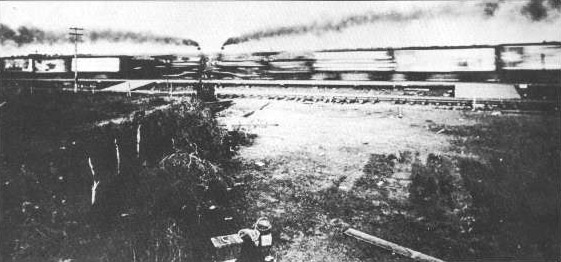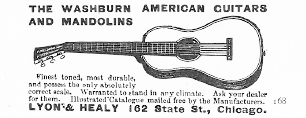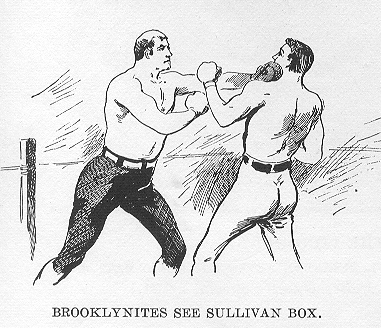
Chorus Girls in a Panic. | “Daredevil” Steve Brodie
Crush Collision!
 Crush, Texas, September 15, 1896-At a little after 5:00 PM, two locomotives, each travelling at a speed of 45 miles per hour, collided head-on in the town of Crush, Texas. The crash was intentional and had been anxiously anticipated by a crowd of at least 30,000 people who had been waiting all day. It was a publicity stunt by the Missouri, Kansas & Texas Railroad and had been highly successful up until the engines actually collided. In fact the Crush Collision might have become an annual event if the first one hadn’t resulted in at least one death and nine serious injuries.[more]
Crush, Texas, September 15, 1896-At a little after 5:00 PM, two locomotives, each travelling at a speed of 45 miles per hour, collided head-on in the town of Crush, Texas. The crash was intentional and had been anxiously anticipated by a crowd of at least 30,000 people who had been waiting all day. It was a publicity stunt by the Missouri, Kansas & Texas Railroad and had been highly successful up until the engines actually collided. In fact the Crush Collision might have become an annual event if the first one hadn’t resulted in at least one death and nine serious injuries.[more]

The plan was conceived by William George Crush, General Passenger Agent of the M. K. & T. (Katy) Railroad. The trains were pulling too many empty passenger cars and Crush was looking for a way to fill them. Having observed that train wrecks always drew large crowds, he hit on the idea of staging his own. He may also have been inspired by a train wreck staged earlier that year by the Cleveland and Hocking Valley Railroad, near Cleveland, Ohio, that drew 40,000 spectators.
Crush chose a long flat stretch of land just north of Waco. It was a natural amphitheater surrounded on three sides by mountains. He set up a makeshift town— not unlike the temporary “hell-on-wheels” towns set up during railroad construction—and named it after himself: Crush, Texas. The collision was scheduled for 4:00 PM on September 15 and advertised by posters and newspaper ads throughout Texas. A passenger could ride to Crush from anywhere on the Katy line for $2.00.
Trains started arriving at Crush at 10:00 on the 15th and every five minutes after that another train would arrive. A crowd of at least 30,000 came to watch the collision. Some estimates were as high as 50,000 people which would have made Crush the largest city in Texas for that day. A tent provided by Ringling Brothers Circus served as a restaurant and ice water was made available. Lemonade stands and carnival games were set up, and Texas politicians took the opportunity to make stump speeches. Though McLennan County was officially dry, large amounts of whiskey were consumed.

The crowd grew restless when 4:00 arrived and there was no collision. 200 hired constables held the spectators back as William Crush rode in front on a white horse threatening to cancel the show if they did not settle down. He was waiting for the arrival of several more trains. Finally at ten past five, Crush waved his hat signaling the engineers to start the show.
Two outdated diamond stack locomotives each pulling six boxcars gradually approached each other for a symbolic “handshake.” One engine painted red with green trim was numbered 999; the other green with red trim was numbered 1001. The boxcars bore advertisements for Ringling Brothers Circus and the Oriental Hotel (“The only modern hotel in Dallas.”) The trains backed up to their starting points then when the signal was given set off, full-tilt, towards each other. Each engineer forced the throttle and whistle open then jumped off the train. Torpedoes set along the track fired as each locomotive passed. Going a combined speed of 90 miles per hour, the two engines collided. They angled upward, like two stallions fighting as the train cars behind telescoped into each other. Then, counter to what Crush had been assured by his engineers, the boilers exploded.
Amid the smoke and steam, timber bolts and pieces of hot iron- from entire boiler plates to shards of shrapnel-filled the air. People in the crowd struck by the debris suffered fractured skulls and broken bones. A flying bolt took out the right eye of photographer J. C. Dean. 19-year-old Earnest Darnelle who had been watching from a tree was struck by five feet of heavy chain. He fell to earth, his head nearly severed.

The crowd stood in silence for several seconds as chaos ensued all around them. Then all at once, those still standing, rushed to the crash to grab souvenirs. At 6:00 return trains began leaving.
The M. K. & T. railroad cleaned up the mess and dismantled the town of Crush forever. They paid all claims without a fight. William George Crush was fired as General Passenger Agent, but it was all for show; he was hired back the next day.

Composer Scott Joplin may have been in the crowd that day. He wrote a song, “The Great Crush Collision March” commemorating the event.
The Dallas Morning News, September 16, 1896
The Dallas Morning News, September 17, 1896
The Dallas News, August 8, 1954
http://www.baylor.edu/lariat/news.php?action=story&story=10054














